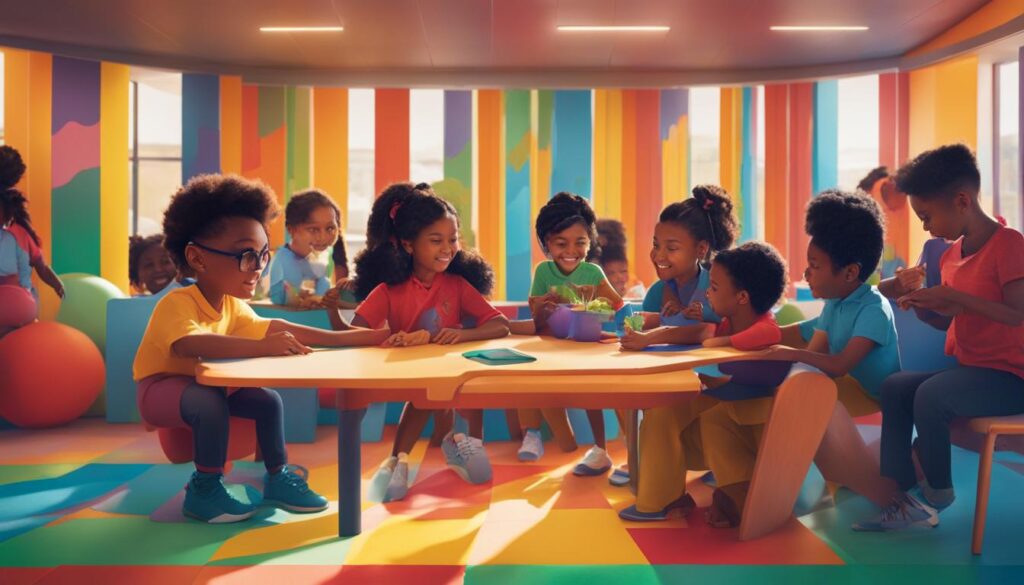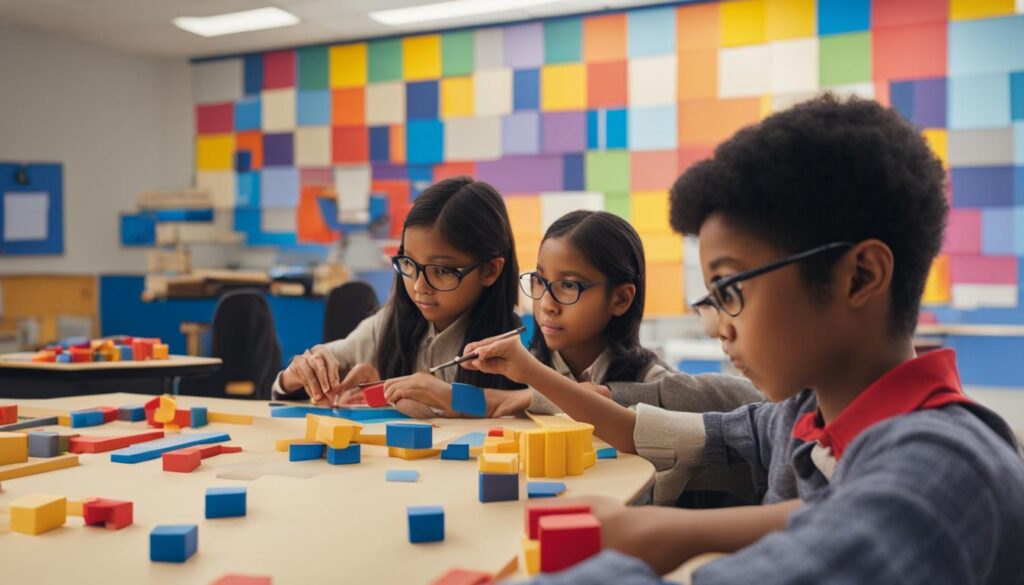What if we could transform education, revolutionize traditional learning methods, and unlock the full potential of every student? Is it possible to lead the future of education and pave the way for lasting progress and innovation in our schools?
In today’s rapidly evolving world, the landscape of education is constantly changing. New technologies, innovative teaching methods, and personalized approaches are reshaping the way we learn and teach. To keep up with this ever-changing environment, education leadership and educational innovation play pivotal roles in transforming education and preparing students for the future.
Join us as we delve into the concept of leading the future of education. Discover how digital learning and personalized education are revolutionizing classrooms and empowering students. Explore the importance of education leadership in driving progress and innovation. Together, let’s harness the power of education to shape a bright and transformative future.
Contents
- 1 How Global Trends Are Reshaping 21st Century Learning
- 2 Can Personalized Learning Unlock Student Potential?
- 3 Game-Based Learning: Engaging Modern Students
- 4 Applying Experiential Learning Across Subjects
- 5 Integrating Social-Emotional Skills in Classrooms
- 6 Global Citizenship Through Language Learning
- 7 Building Critical Thinking With Impactful Strategies
- 8 Fostering Inclusion and Belonging
- 9 Demystifying the Math Phenomenon in Ontario
- 10 Innovating Beyond Traditional Letter Grades
- 11 FAQ
- 11.1 How can leading the future of education drive progress and innovation in the education sector?
- 11.2 What are the global trends reshaping 21st-century learning?
- 11.3 How can personalized learning unlock student potential?
- 11.4 How can game-based learning engage modern students?
- 11.5 How can experiential learning be applied across different subjects?
- 11.6 Why is it important to integrate social-emotional skills in classrooms?
- 11.7 How can language learning foster global citizenship?
- 11.8 How can critical thinking skills be built in students?
- 11.9 How can classrooms foster inclusion and belonging?
- 11.10 What are innovative approaches to teaching and learning math in Ontario?
- 11.11 How can education innovate beyond traditional letter grades?
- 12 Source Links
Key Takeaways:
- Education leadership plays a crucial role in transforming education and driving innovation.
- Digital learning and personalized education are shaping the future of education.
- The future of education requires embracing change, innovation, and adapting to students’ needs.
- By leading the future of education, we can unlock the full potential of every student.
- Education leaders have an opportunity to create a lasting impact on the education landscape.
How Global Trends Are Reshaping 21st Century Learning
The future of education is being shaped by global trends that are revolutionizing the learning landscape. One of the key driving forces behind this transformation is education technology. As advancements in technology continue to progress at an unprecedented rate, so too does its impact on education.
Education technology, also known as EdTech, is cutting-edge technology that is specifically designed to enhance and support the learning experience. From interactive online platforms to virtual reality simulations, EdTech is enabling educators to engage students in new and innovative ways. It is revolutionizing the traditional classroom model and paving the way for personalized, student-centered learning.
Staying up-to-date with the latest educational innovations is now more important than ever. Incorporating these advancements into the classroom can better prepare students for the future by equipping them with the skills and knowledge necessary to thrive in an increasingly digital world.
As education technology evolves, educators must adapt and embrace these changes. By integrating cutting-edge education technology into their teaching strategies, educators can create dynamic and engaging learning environments that foster critical thinking, problem-solving, and collaboration.
In conclusion, the progress in education technology is reshaping 21st century learning. It is crucial for educators to embrace these trends and incorporate them into their classrooms. By doing so, they can provide students with the tools and skills needed to thrive in an ever-changing world.
Can Personalized Learning Unlock Student Potential?

Personalized learning is an innovative approach that holds immense potential for unlocking the true abilities of students. By tailoring education to individual students’ needs, interests, and learning styles, personalized learning empowers students to thrive academically, emotionally, and socially.
One of the key benefits of personalized learning is its ability to address the diverse needs of students. Every student is unique, and personalized education recognizes and celebrates this individuality. By providing customized learning experiences, educators can create an environment where students feel seen, valued, and supported.
Implementing personalized learning strategies requires a thoughtful approach. Educators must develop a deep understanding of each student’s strengths, weaknesses, and learning preferences. By leveraging educational best practices, such as differentiated instruction, adaptive technologies, and flexible learning pathways, educators can tailor their teaching to meet the specific needs of each student.
Furthermore, personalized learning prepares students for the future by fostering essential skills such as critical thinking, problem-solving, collaboration, and self-directed learning. As the world rapidly evolves, these skills are becoming increasingly vital for success in the 21st-century workforce.
At Canada Global Academy, we are committed to personalized education and empowering students to reach their full potential. Through our School Partnership Program, we provide schools with the tools, resources, and support they need to implement personalized learning effectively. Visit https://canadaglobalacademy.com/school-partnership-program/ to learn more about how our program is revolutionizing schools and preparing students for the future.
Game-Based Learning: Engaging Modern Students
In today’s digital age, educators are constantly seeking innovative and engaging methods to captivate the attention of modern students. One powerful approach that has been gaining momentum is game-based learning. By incorporating gamification principles into the educational experience, teachers can create a dynamic environment that promotes active learning, enhances student motivation, and fosters the development of critical thinking skills.
Game-based learning leverages the inherent appeal of games to immerse students in interactive and immersive learning experiences. It harnesses the power of educational best practices to create engaging scenarios that challenge students while providing immediate feedback and rewards. This approach not only enhances student engagement but also improves information retention and application.
Research has shown that game-based learning can effectively address the needs of modern students who have grown up in a digital world. It taps into their innate familiarity with technology and their natural inclination towards interactive and experiential learning. By blending elements of play and education, teachers can create a learning environment that is both enjoyable and effective.
When incorporating game-based learning into the curriculum, there are several best practices to consider. Firstly, it is important to align the game design with the learning objectives, ensuring that the games reinforce the targeted knowledge and skills. Additionally, incorporating elements of competition and collaboration can boost student engagement and promote social interaction.
Moreover, game-based learning can be seamlessly integrated into blended learning environments. By combining online and offline activities, teachers can provide a well-rounded educational experience that combines the benefits of technology with the richness of face-to-face interaction.
In conclusion, game-based learning is an effective approach to engage modern students and enhance their learning experience. By leveraging the power of games and educational best practices, teachers can create an immersive and dynamic learning environment that promotes active participation and critical thinking skills. Incorporating game-based learning into the curriculum allows educators to harness the potential of technology and provide students with a truly engaging educational experience.
| Benefits of Game-Based Learning | Best Practices for Incorporating Game-Based Learning |
|---|---|
|
|
Applying Experiential Learning Across Subjects

In today’s rapidly evolving educational landscape, experiential learning has emerged as a powerful pedagogical approach that promotes active engagement and deep understanding among students. This section will explore the concept of experiential learning and its application across various subjects, fostering creativity, critical thinking, and problem-solving skills.
Experiential learning encourages students to actively participate in hands-on, real-world experiences, bridging the gap between theoretical knowledge and practical application. By immersing themselves in authentic tasks and challenges, students gain a deeper understanding of concepts and develop the skills necessary for success in the modern world.
One form of experiential learning gaining popularity is project-based learning. This approach allows students to work on meaningful projects that simulate real-world scenarios, encouraging collaboration, innovation, and problem-solving. Through project-based and experiential learning, students develop transferable skills such as communication, teamwork, and adaptability, which are essential for their future careers.
Moreover, experiential learning goes beyond traditional classroom boundaries. With the integration of technology and the internet, students can explore virtual simulations, conduct research, and engage with experts from diverse fields. This enhances their learning experience and prepares them to navigate a globally interconnected society.
Education innovation trends further promote experiential learning as an effective teaching methodology. Schools and educational institutions are embracing innovative practices and approaches that prioritize experiential learning, recognizing its potential to enhance student engagement, motivation, and overall academic success.
“Experiential learning provides students with the opportunity to actively apply their knowledge and skills, fostering a deeper understanding of concepts and promoting lifelong learning.” – Dr. Sarah Johnson, education innovation expert
To apply experiential learning across subjects, educators can incorporate the following strategies:
- Design projects that align with the curriculum and allow students to explore real-world problems and challenges.
- Encourage collaborative and interdisciplinary projects that integrate multiple subjects, fostering cross-curricular connections.
- Provide opportunities for students to engage with professionals and experts in the field through mentorship and guest lectures.
- Utilize technology tools and resources to create virtual simulations, interactive experiences, and multimedia presentations.
- Regularly reflect on the learning process and encourage students to assess their own growth and development.
By embracing experiential learning across subjects, educators can empower students to become active learners, critical thinkers, and innovative problem solvers. As education continues to evolve, integrating experiential learning into the curriculum is key to preparing students for the challenges and opportunities of the 21st century.
Continue reading to explore how Canada Global Academy’s School Partnership Program is revolutionizing schools. Visit our website to learn more.
Integrating Social-Emotional Skills in Classrooms

Integrating social-emotional skills in classrooms is essential for promoting students’ overall well-being and academic success. By teaching skills such as empathy, resilience, and critical thinking, educators can equip students with the tools they need to navigate the complexities of their social and emotional lives.
Social-emotional learning best practices focus on creating a supportive and inclusive learning environment that fosters character development and resilience. These practices help students develop a deeper understanding of their emotions, build positive relationships, and make responsible decisions.
Developing critical thinking skills is another crucial aspect of social-emotional learning. By fostering critical thinking, educators encourage students to analyze issues from multiple perspectives, evaluate evidence, and make informed judgments. This skill promotes independent thought and prepares students to navigate complex challenges in their personal and academic lives.
“Integrating social-emotional skills in classrooms is vital for nurturing students’ overall well-being and preparing them for success in the 21st century.”
Building character and resilience through social-emotional learning helps students develop a strong sense of self, empathy for others, and the ability to handle adversity. These qualities are essential for students’ personal growth and success in any professional or personal endeavor they may pursue.
To incorporate social-emotional learning into the curriculum, educators can implement various strategies. These strategies may include integrating social-emotional skills into daily classroom routines and activities, utilizing cooperative learning techniques, and providing opportunities for self-reflection and self-expression.
By embracing social-emotional learning best practices, educators can create an environment where students feel valued, supported, and empowered to reach their full potential. The positive impact of social-emotional learning extends beyond the classroom, equipping students with the skills they need to thrive in an interconnected and constantly evolving world.
| Benefits of Integrating Social-Emotional Skills in Classrooms |
|---|
| Enhanced well-being and mental health of students |
| Improved social relationships and communication skills |
| Increased empathy and understanding of others |
| Development of critical thinking and problem-solving abilities |
| Building resilience and adaptability in the face of challenges |
| Fostering a positive and inclusive school culture |
Global Citizenship Through Language Learning

In today’s interconnected world, global citizenship is a crucial skill that empowers individuals to navigate diverse cultures, connect with people from different backgrounds, and contribute positively to society. One powerful way to foster global citizenship is through language learning. Language education programs play a vital role in promoting cultural understanding, communication skills, and empathy among students.
Language learning not only equips students with the ability to communicate in different languages but also exposes them to the rich diversity of the world. By learning a new language, students gain insights into different cultures, traditions, and perspectives. They develop a global mindset that allows them to appreciate and embrace differences, fostering a sense of unity and interconnectedness.
“Language is the road map of a culture. It tells you where its people come from and where they are going.” – Rita Mae Brown
Implementing mastery-based learning in language education programs further enhances the development of global citizenship. Mastery-based learning focuses on student-centered instruction, allowing learners to progress at their own pace and achieve mastery in specific language skills. This approach promotes deep understanding, critical thinking, and problem-solving abilities, enabling students to engage meaningfully with diverse cultures and communities.
Through language education programs that prioritize global citizenship and implement mastery-based learning, students develop proficiency in multiple languages, becoming effective communicators in international settings. They acquire the skills necessary to collaborate, negotiate, and build bridges across cultures, preparing them to be active participants in an increasingly interconnected world.
| Benefits of Global Citizenship Through Language Learning |
|---|
| Enhanced cultural understanding and appreciation |
| Improved communication and language skills |
| Increased empathy and respect for diverse perspectives |
| Development of a global mindset |
| Preparation for international collaboration and global careers |
Building Critical Thinking With Impactful Strategies

Critical thinking is a vital skill that empowers students to analyze information, make reasoned decisions, and creatively solve complex problems. Developing critical thinking skills is essential for academic success and preparing students for the challenges of the future. In this section, we will explore strategies and techniques that educators can employ to foster critical thinking and problem-solving abilities in their students.
One effective strategy for building critical thinking is by encouraging open-ended questioning. By asking thought-provoking questions, educators can stimulate students’ analytical thinking and prompt them to explore multiple perspectives. This helps students develop a deeper understanding of the subject matter and encourages them to think critically about the information presented.
Growing with a growth mindset: Another approach to developing critical thinking skills is through fostering a growth mindset. A growth mindset is the belief that abilities and intelligence can be developed through dedication and hard work. By instilling a growth mindset in students, educators can cultivate resilience, perseverance, and an eagerness to learn. These qualities are essential for developing critical thinking skills as students embrace challenges, persist in the face of setbacks, and continuously seek opportunities for growth.
Furthermore, incorporating real-world problem-solving activities into the curriculum can provide students with opportunities to apply critical thinking skills in practical contexts. Project-based learning, for example, allows students to engage in hands-on, experiential tasks that require them to analyze information, think critically, and find innovative solutions.
“The essence of critical thinking is to ask the right questions and to apply logical reasoning to arrive at well-informed conclusions.”
Collaborative learning environments also play a crucial role in fostering critical thinking skills. By working collaboratively on group projects or engaging in discussions, students can learn from diverse perspectives, challenge their own assumptions, and develop their analytical and communication skills.
Lastly, incorporating technology and multimedia resources into lesson plans can provide students with interactive opportunities to practice critical thinking. Online simulations, virtual labs, and multimedia presentations can encourage students to analyze information, think critically, and make informed decisions in a digital and visually engaging format.
Strategies for Developing Critical Thinking Skills
| Strategy | Description |
|---|---|
| Open-ended questioning | Encourage thought-provoking questions to stimulate critical thinking |
| Growth mindset | Foster the belief that abilities can be developed through dedication and hard work |
| Real-world problem solving | Incorporate practical activities that require critical thinking to find solutions |
| Collaborative learning | Provide opportunities for students to learn from diverse perspectives through group projects and discussions |
| Technology integration | Utilize digital tools to engage students in interactive critical thinking activities |
By implementing these strategies, educators can empower students to become critical thinkers, equipping them with the skills they need to thrive in a complex and ever-changing world.
Fostering Inclusion and Belonging

In education, fostering inclusion and belonging is of paramount importance. Creating inclusive learning environments that respect and embrace diversity is a key aspect of ensuring every student feels valued and accepted. By designing inclusive learning environments, schools can provide an equitable education experience for all students, regardless of their backgrounds or abilities.
To achieve this, schools can implement various strategies for education innovation that prioritize inclusion and belonging. These strategies are centered on creating an environment where every student feels comfortable, supported, and empowered to succeed.
One effective strategy is to incorporate diverse perspectives into the curriculum. This can be done by including a wide range of voices, experiences, and cultures in the learning materials and resources. By doing so, students are exposed to different perspectives and gain a better understanding of the world around them.
Another important strategy is to provide professional development and training for teachers to enhance their understanding and implementation of inclusive practices. This includes training on cultural competency, addressing biases, and utilizing inclusive teaching methods. By equipping educators with the necessary tools and knowledge, they can create an inclusive learning environment that caters to the individual needs of every student.
Additionally, collaboration and partnership with parents, families, and the community play a crucial role in fostering inclusion and belonging. Schools can engage families in the education process and seek their input to create a supportive and inclusive learning environment. This collaborative approach strengthens the bond between the school and the community, creating a sense of belonging and shared responsibility for student success.
| Strategies for Fostering Inclusion and Belonging | Benefits |
|---|---|
| Implement diverse perspectives in the curriculum | – Enhances students’ understanding of different cultures – Promotes empathy and respect for diversity |
| Provide professional development on inclusive practices for teachers | – Equips teachers with the knowledge and tools to create inclusive learning environments – Addresses biases and promotes cultural competency |
| Collaborate with parents, families, and the community | – Creates a supportive and inclusive environment – Strengthens the bond between school and community – Fosters a sense of belonging and shared responsibility |
By prioritizing inclusion and belonging, schools can create a positive learning environment where every student feels valued, respected, and supported. This not only enhances academic achievement but also promotes social-emotional development and prepares students for a diverse and interconnected world.
Explore how Canada Global Academy’s School Partnership Program is revolutionizing schools. Visit https://canadaglobalacademy.com/school-partnership-program/ to learn more.
Demystifying the Math Phenomenon in Ontario

This section of the article will focus on demystifying the math phenomenon in Ontario, exploring the current challenges in math education and innovative approaches to teaching and learning math. It is essential to rethink assessments and evaluations, rewrite curriculum standards, and reimagine professional development for math educators. By addressing these key areas, we can foster a transformative math education system that empowers students and prepares them for future success.
Math education plays a crucial role in developing critical thinking skills, problem-solving abilities, and logical reasoning in students. However, many educators and students in Ontario face difficulties in this subject, impacting academic performance and confidence levels.
In order to address these challenges, it is necessary to rethink assessments and evaluations. Traditional methods often focus solely on exams and grades, rather than evaluating a student’s understanding, problem-solving strategies, and critical thinking abilities. By adopting alternative assessment approaches, such as project-based assessments, portfolio assessments, and real-world applications, we can provide a more comprehensive and accurate evaluation of a student’s math proficiency.
Furthermore, rewriting curriculum standards is crucial to ensuring that math education aligns with the needs of today’s learners. The curriculum should incorporate real-world contexts, interdisciplinary connections, and relevant problem-solving scenarios. By making math education more relevant and meaningful, students can better understand the practical applications of math in their everyday lives.
Professional development plays a vital role in supporting math educators in delivering high-quality instruction. It is crucial to reimagine professional development programs to provide educators with the knowledge, skills, and resources necessary to inspire and engage students in math learning. Professional development should focus on instructional strategies that promote hands-on, inquiry-based learning, technology integration, and collaborative problem-solving.
Innovating Beyond Traditional Letter Grades
Education is constantly evolving, and as we strive to prepare students for the future, it is crucial to challenge traditional methods of assessment and evaluation. The time has come to innovate beyond traditional letter grades in education, opening up a world of opportunities to redefine student success and foster holistic growth and skill development.
Education innovation is at the forefront of this movement, with educators, policymakers, and researchers exploring new ideas and frameworks to reform education policies. By reimagining the assessment and evaluation process, we can move away from a narrow focus on grades and instead emphasize a comprehensive understanding of student capabilities.
Redefining student success goes beyond academic achievements. It involves recognizing and nurturing a range of skills and qualities, including critical thinking, creativity, communication, collaboration, and resilience. Education innovation frameworks guide us in this quest, offering valuable insights and strategies for developing well-rounded individuals who are prepared to navigate the challenges of an ever-changing world.
At Canada Global Academy, we are committed to pushing the boundaries of education innovation. Through our School Partnership Program, we work collaboratively with schools to revolutionize educational practices and create meaningful learning experiences for students. Together, we can challenge the status quo, embrace new assessment methods, and redefine student success in a way that inspires and empowers the next generation.
FAQ
How can leading the future of education drive progress and innovation in the education sector?
Leading the future of education involves being at the forefront of educational innovation and transformation. By embracing new technologies, pedagogical approaches, and best practices, education leaders can create cutting-edge education systems that prepare students for the future.
What are the global trends reshaping 21st-century learning?
Some of the key trends shaping 21st-century learning include advancements in education technology, the rise of digital learning, personalized education approaches, and the integration of experiential learning and game-based learning into the curriculum.
How can personalized learning unlock student potential?
Personalized learning tailors education to individual students’ needs, interests, and learning styles. By customizing instruction, providing targeted feedback, and leveraging technology, educators can create personalized learning experiences that engage students and enhance their academic growth.
How can game-based learning engage modern students?
Game-based learning involves using educational games and gamification techniques to make learning more interactive, enjoyable, and meaningful for students. It enhances student motivation, promotes active learning, and improves knowledge retention by harnessing the power of game mechanics and storytelling.
How can experiential learning be applied across different subjects?
Experiential learning incorporates hands-on, real-world experiences into the curriculum to deepen students’ understanding and application of knowledge. It can be applied in various subjects by creating opportunities for students to engage in authentic tasks, projects, and field experiences that bridge theory and practice.
Why is it important to integrate social-emotional skills in classrooms?
Teaching social-emotional skills, such as empathy, resilience, and critical thinking, is essential for students’ overall well-being and academic success. These skills help students navigate challenges, build positive relationships, and develop the emotional intelligence needed to thrive in an interconnected world.
How can language learning foster global citizenship?
Language education programs play a vital role in promoting cultural understanding, communication skills, and empathy. By fostering proficiency in multiple languages and exposing students to diverse cultures, language learning prepares them to become responsible global citizens.
How can critical thinking skills be built in students?
Critical thinking can be fostered by providing students with opportunities to analyze, evaluate, and solve complex problems. By teaching students to question assumptions, consider multiple perspectives, and seek evidence, educators can develop their critical thinking abilities and prepare them for future challenges.
How can classrooms foster inclusion and belonging?
Creating inclusive learning environments involves designing classrooms that respect and embrace diversity. By embracing differentiated instruction, promoting collaboration, and valuing each student’s unique contributions, educators can foster a sense of belonging for all students.
What are innovative approaches to teaching and learning math in Ontario?
To demystify the math phenomenon in Ontario, educators are rethinking assessments and evaluations, rewriting curriculum standards, and providing impactful professional development for math educators. These approaches aim to enhance students’ math skills and cultivate a positive attitude towards math.
How can education innovate beyond traditional letter grades?
Education innovation involves redefining student success beyond traditional letter grades. By implementing innovative assessment and evaluation methods, focusing on holistic student growth and skill development, educators can provide a more comprehensive and meaningful measure of students’ abilities and achievements.
Source Links

Education Disruptor proudly collaborates with leading innovators in the education sector who share our passion for reshaping K12 education. We extend our sincere gratitude to the following organizations for their support. Ethos Education in collaboration with Canada Global Academy who are the exclusive authorized provider of the 3rd globally ranked Ontario Ministry of Education‘s renowned K12 curriculum and Digital Learning Platform outside of Canada.
Through their School Partnership Program, they empower schools worldwide to attain Canadian Accreditation, providing the opportunity to establish themselves as Canadian Accredited schools. Additionally, home-based businesses can run their own Canadian Accredited Micro-School. Contact them today to learn more!


